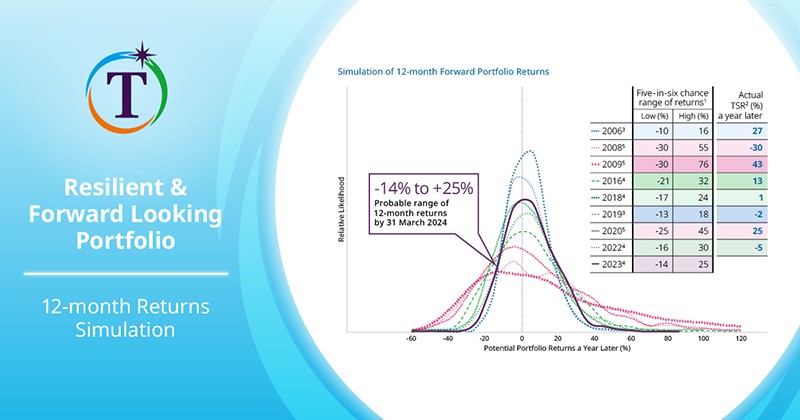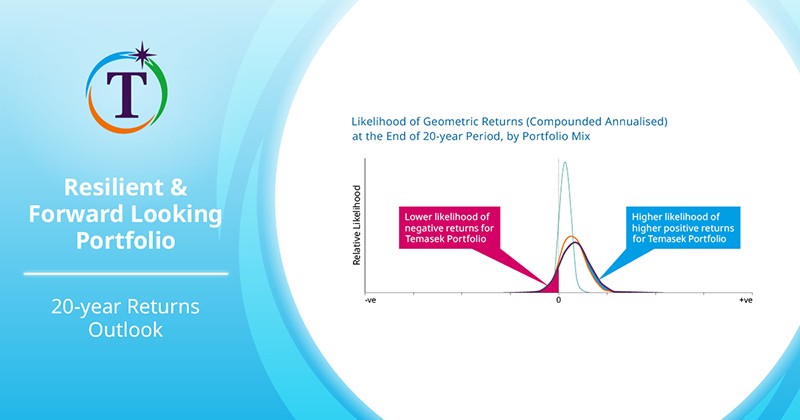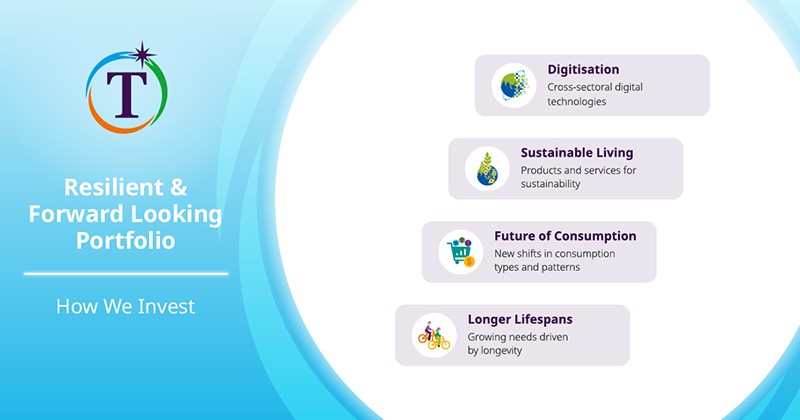How We Manage Risks
There are inherent risks whenever we invest, divest, or hold our assets, and wherever we operate.
Jump to
We adopt a long term view of our investments, with the flexibility to take concentrated positions. We invest across all stages of the business life cycle, from early stage and/or unlisted, to large or listed assets. We do not have targets for investing by asset class, country, sector, or single name.
Our long investment horizon means we have a portfolio of predominantly equities which deliver higher risk-adjusted returns over the long term. Our stable funding base allows us to invest and benefit from companies with high growth potential through listed and unlisted assets (including private equity funds).
Consequently, given the high equity component, our portfolio is expected to have higher year-to-year volatility of annual returns, with a greater risk of negative returns in any one year.
Our investment posture is to ride out short term market volatility and focus on generating sustainable returns over the long term.
Given the expected volatility, we manage our leverage and liquidity prudently for resilience and investment flexibility, even in times of extreme stress.
We have no tolerance for risks that could damage the reputation and credibility of Temasek.
Our investment posture is coupled with a culture of risk ownership throughout the organisation. This applies to both our investment activities and institutional capabilities. Our risk-sharing compensation philosophy puts the institution above the individual, emphasises long term over short term, and aligns the interests of our staff with those of our shareholder.
We have no tolerance for risks that could damage the reputation and credibility of Temasek.
Our Organisational Risk Management Framework includes Risk Return Appetite Statements which set out various levels of risks tolerance, from reputational risk to liquidity risk, and risk of sustained loss of overall portfolio value over prolonged periods.
Organisational Risk Management Framework
Risk Return Appetite Statements
We have no tolerance for risks that could damage Temasek’s reputation and credibility
- Temasek rigorously identifies potential sources of reputational risk and how each type of reputation risk is to be managed
We focus on performance over the long term
- We target a long term portfolio return that exceeds our risk-adjusted cost of capital
- We are prepared to accept fluctuations in annual reported results provided we are compensated by superior longer term returns and it does not affect our ability to survive
We have flexibility to take concentrated positions
- Where good investment opportunities allow for superior long term performance, Temasek has the flexibility to take portfolio concentrations in specific sectors, geographies, themes, or individual assets
- We adopt a disciplined approach to investing, with end-to-end assessment frameworks and processes for each asset class
- For direct equity investments this includes developing a deep understanding of each investment in order to determine the intrinsic value for investment, divestment, and hold decisions
We maintain a resilient balance sheet
- We maintain leverage and liquidity to ensure resilience and flexibility even in times of extreme stress
We evaluate the potential for sustained loss of overall portfolio value over prolonged periods, and use different scenarios to test our resilience
Risk Pillars
Investment Risk
Liquidity & Leverage Risk
Portfolio Value Risk
Operational Risk
Cybersecurity Risk
Legal & Regulatory Risk
Macro and Geopolitical Risk
Risk Governance
There are various risk pillars by which we assess risks across a wide spectrum of domains. These risk pillars are supported by specialised teams comprising members from different functions and report to senior management for general oversight. We embed risk management in our systems and processes. These include our approval authority delegation, company policies, standard operating procedures, and risk reporting to our Board and Board Risk & Sustainability Committee.
We embed risk management in our systems and processes.
Investment Risk
All new investment proposals are subject to a due diligence process commensurate with the nature of the investment to be made. This is intended to validate business theses and examine material risks. The exact scope of the required pre-investment analysis will be determined based on the specific risk profile being considered. Pre-investment analysis is done by our deal origination teams whose expertise is supplemented by internal experts or external professionals who perform additional due diligence in specialised areas such as legal, tax, and climate risks.
When we invest in companies, we will conduct a bottom-up fundamental valuation analysis, in addition to doing due diligence. We also use an appropriate risk-adjusted cost of capital to determine a best estimate of company valuation. Our analysis enables us to estimate a fair value for the company. We also generate stress case valuations to help us gauge the degree of variability in potential future returns under different assumptions.
We will compare our reasonable estimate of fair value with current market pricing and valuation to determine if an investment makes sense at the proposed price and if it provides sufficient spread to our risk-adjusted cost of capital (RACOC), including an estimated cost of carbon emissions.
The cost of capital used in the modelling process will be a weighted value based on estimations of the likely financing structure of the company and its costs of debt and equity capital. We utilise the capital asset pricing model to derive an equity cost based on the relative riskiness of the business operations being undertaken. This takes into account leverage, the type of industry, and the countries of operation of the company. Investments in riskier sectors or markets will have higher costs of capital. We then add an illiquidity risk premium for unlisted investments and a venture risk premium for early stage investments to account for their respective risks.
We use the individual RACOC to normalise the assessment of risks, when we compare the relative attractiveness among investment opportunities. We may dial up or down the required spread over RACOC as a tool to tighten or loosen our investment risk appetite.
Depending on the external outlook and our investment stance, we may choose to invest in opportunities with positive expected returns, which are below their respective individual RACOC. We deploy our excess liquidity in short term liquid investments that may give us returns lower than our cost of capital, as we assess opportunities to deploy in longer term investments.
All prospective investments must be reviewed and approved by our Senior Divestment and Investment Committee (SDIC).
Investment proposals made to SDIC are typically submitted by both market and sector teams who provide geographic and industry expertise. Depending on the size or risk significance, these proposals may be escalated to our Board Executive Committee or Board for a final decision.
Post-investment monitoring is performed by the investment teams on a continuous basis, and formally by senior management, at quarterly review meetings chaired by the Chief Investment Officer. They assess if the investment is performing to our expectations and whether any action should be taken.
Foreign Exchange Risk
Our projected risk-adjusted return for each investment proposal takes into account any anticipated foreign exchange (FX) movements.
We also selectively hedge FX exposures from confirmed nearer term cash flow and expected divestments within our forecast period.
Environmental, Social, and Governance (ESG) Risk
Our investments are evaluated on the basis of our ESG framework, which encompasses material ESG considerations across the investment process including a focus on the analysis of climate-related risks.
For example, we consider the effects of climate change, including physical and transition risks, in our investment analysis in sectors with higher exposure to climate risks. We use an internal carbon price of US$50 per tonne of carbon dioxide equivalent (tCO2e) to better assess the resiliency of companies to transition, and factor it into our returns expectation. We expect to increase our internal carbon price progressively to US$100 per tCO2e by the end of the decade.
Liquidity & Leverage Risk
We manage our leverage, liquidity, and balance sheet prudently for resilience and flexibility. We manage our liquidity risk by ensuring that our primary recurring sources of cash flows can cover our non-discretionary expenses, such as operating expense, taxes, and interest to bondholders.
Our recurring income includes divestments, dividends from portfolio companies, and distributions from funds.
Our liquidity is supported primarily by our recurring income, supplemented by proceeds from debt issuances via Temasek Bonds and Euro-commercial Paper, as well as bank borrowings. Total leverage is restricted to an overall debt limit set by our Board. The debt limit takes into account our portfolio value, shareholder funds, forecast cash flow, and credit profile. We maintain a well distributed debt maturity profile, avoiding large refinancing risk in any one year.
(for year ended 31 March)
Key Recurring Income vs Debt Maturity Profile (S$b)
Besides maintaining the discipline of regular divestments to generate liquidity, the construction of our portfolio enables us to tap into liquidity in times of stress. As at 31 March 2023, our liquid and sub-20% listed assets alone were about five times our debt outstanding. In the very unlikely extreme scenario where we have no other cash inflows, aside from using our liquidity balance, divesting a small part of our liquid and sub-20% listed assets would be sufficient to cover the total debt outstanding in under two weeks.
Further, Temasek does not provide any financial guarantees for the obligations of our portfolio companies.
Portfolio Value Risk
We track and manage risks proactively, through economic and market cycles, including specific risks at the asset level.
We assess the sustained impact of multiple risk scenarios on the intrinsic value of our investments. The aggregate of these changes provides an estimate of the portfolio level variation in present value, future cash flows, and income in each scenario.
As illustrated in the diagram below, Fundamental Earnings Impact is our estimate of sustained loss. This is different from Trough Impact, which includes mark to market effects due to short term increases in risk aversion. We do not manage our portfolio to short term mark to market changes.
Illustration of Fundamental Earnings Impact
Based on our assessments of any likely sustained loss, consistent with our intrinsic value discipline, we may manage the risks as follows:
- Divest, hold, or protect the individual investment impacted;
- Change the portfolio composition for the long run;
- Take actions to protect the portfolio, for example, by entering into tactical single stock, index or rates hedges.
Operational Risk
We have institutionalised a risk incident reporting process which encourages staff to proactively report gaps, perform root cause analysis, and adopt appropriate remediating measures for all reported risk incidents. This contributes to a work environment with a focus on excellence and helps build a healthy risk management culture in Temasek.
We are committed to continuously improve the way we manage business continuity risks. Our contingency management framework ensures business continuity and manages incidents arising from safety, physical security, cybersecurity, and other threats. The framework also takes into account the potential impact of emerging risks, such as physical threats and health situations around the world.
Over the year, we conducted response exercises regularly to ensure that our contingency plans and disaster recovery remain effective, relevant, and adequate, including responses to failure of important information infrastructure and potential physical threats. We constantly work on improving our capabilities to ensure that our staff and visitors remain safe, and that critical business functions can resume functioning in a timely manner during times of emergencies.
In addition, staff volunteers are trained as part of our Care Supporter Programme to provide psychological support to their fellow colleagues affected by traumatic events. Our Care Supporters network has been extended across our international offices and is integrated with our contingency management plans for a holistic response to incidents.
Cybersecurity Risk
To protect our firm and investments from threats in the evolving cybersecurity landscape, we regularly monitor and track cyber risks and continuously enhance our cybersecurity defence and resilience. We continually assess and perform regular testing of our environment to ensure our cybersecurity controls are effective. We engage our portfolio companies and partners on a regular basis to champion best practices in the cyber space and elevate our respective cyber defence and resilience.
We regularly monitor and track cyber risks and continuously enhance our cybersecurity defence and resilience.
Our cybersecurity team, supported by expertise from our cybersecurity platform companies, assess the cybersecurity health of potential investee companies as part of the investment due diligence process. Their assessment is based on four areas: key data assets; regulatory requirements and data privacy; cybersecurity policy and governance; and assessment and incidents. If additional information is required after their assessment, a comprehensive cybersecurity scan on potential investee companies may be conducted.
Legal & Regulatory Risk
We comply with all obligations under Singapore laws and regulations, including those arising from international treaties and UN sanctions, as well as the laws and regulations of jurisdictions where we have investments or operations.
Our global footprint, coupled with a fast and ever evolving legal and regulatory environment and increasing enforcement and oversight by authorities, reinforces the importance of robust transactional processes and compliance programmes. We continue to build expertise across novel and developing areas that we are involved in to ensure that we are able to identify and manage legal, regulatory, and compliance risks appropriately.
We comply with the laws and regulations of jurisdictions where we have investments or operations.
Our Legal & Regulatory (L&R) department ensures that policies, processes, and systems are appropriately designed and implemented, consistent with applicable laws, and, aligned with Board directives to advance the firm’s objectives while managing risks and safeguarding its interest. For instance, our policy on derivative transactions permits only personnel authorised by a board resolution to enter into such transactions within strict scopes and limits on behalf of specific designated entities. Other examples include implementing policies and control processes to prevent financial crime such as bribery and corruption, and sanctions violations, and to ensure compliance with foreign direct investment, merger control and export controls regimes. We continuously monitor regulatory developments to ensure that our policies, procedures, and monitoring systems reflect these changes.
L&R monitors regulatory reporting compliance through a systematic securities tracking process. Regulatory requirements and monitoring systems are continually reviewed and updated to reflect changes in laws and regulations, governance principles, and market practices.
We encourage and facilitate the development of a sound corporate culture that incentivises good staff behaviour. High ethical standards and compliance with applicable laws and regulations are expected in the pursuit of our business interests. Specific attention is directed at governance, incentive systems, and training.
Our policy permits only personnel authorised by a board resolution to enter into derivative transactions within strict scopes and limits.
At the core of this is our Temasek Code of Ethics and Conduct (T-Code) and its related policies that guide our Board directors and staff in their daily dealings and conduct. With integrity as the key overarching principle, T-Code policies cover areas such as anti-bribery, whistle-blowing, management of confidential information, and prohibition against insider trading. Our annual staff bonus plans include T-Code compliance requirements.
Macro and Geopolitical Risk
Over the last decade, besides the ever-changing macroeconomic landscape, we have seen heightened geopolitical tensions arising from events such as war and the pandemic, as well as great power rivalry.
Our views around the global economy help to guide Temasek’s investment stance and our overall deployment pace. We also recognise that there has been a renewed and urgent focus on national security (encompassing economic security and competition), resiliency including energy and commodity sufficiency, data ownership, techno-nationalism, and the use of subsidies, to name a few pressing issues. The presumptive gains from the globalisation of trade, investment, and technology are subject to ever greater scrutiny.
To stay ahead of these developments, our International Policy and Governance teams — located in Beijing, Brussels, Singapore, and Washington, DC — actively monitor geopolitical risks and anticipate policy developments in our key markets that could impact our activities.
Through our engagement with thought leaders and authorities, we exchange views so as to promote better outcomes for all in the design and implementation of policy. In particular, we aim to promote a better understanding of how we operate based on commercial principles, and independent of government interference and support.


